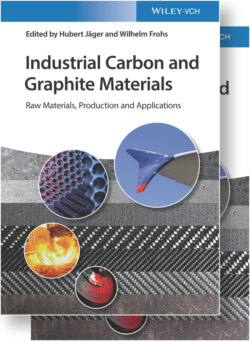Читать книгу Industrial Carbon and Graphite Materials - Группа авторов - Страница 285
6.1.2.4. Uses and Economic Aspects
ОглавлениеWorldwide annual consumption of industrial carbon was about 25 × 106 t/a in 1994, excluding metallurgical coke (see Table 6.1.2.5 and Figure 6.1.2.10); main products are carbon anodes and carbon black. Two thirds of this margin is calcinate from petroleum coke [6, 7, 27, 28].
Table 6.1.2.5 World Production of Industrial Carbon 1994.
| Carbon products | Production (t/a) | Average product value ($/t) | Market value (109 $/a) |
|---|---|---|---|
| From petroleum coke | |||
| Carbon anodes | 9 × 106 | 700 | 6.3 |
| Söderberg anodes | 4 × 106 | 500 | 2.0 |
| Graphite electrodes | 1.1 × 106 | 5500 | 6.05 |
| Reduction medium/TiO2 process | 2 × 106 | 600 | 1.2 |
| Partly from petroleum coke | |||
| Carbon cathodes | 6 × 105 | 1300 | 0.78 |
| From other products | |||
| Carbon black | 8 × 106 | 1500 | 12 |
| Activated carbons | 5 × 105 | 3000 | 1.5 |
| Carbon construction materials | 1 × 105 | 800 | 0.8 |
| Electrographite powder | 8 × 104 | 1500 | 0.12 |
| Carbon fibers | 6 × 104 | 7 × 104 | 4.2 |
| Synthetic diamonds | 50 | 15 × 106 | 0.75 |
| Total | ∼24 × 106 | ∼36 |
Figure 6.1.2.10 Using of calcined petroleum coke 2014.
Figure 6.1.2.11 World market profile for petroleum coke 2010.
In 2014, the production of calcined petroleum coke is expected to be 29 × 106 t/a with 74% about 21.5 × 106 t/a being used for aluminum anodes.
Figure 6.1.2.11 shows the world market profile for petroleum coke in 2010 [6, 7, 29]. The relations are the same as now: more than 70% of petroleum coke is burned as fuel.
